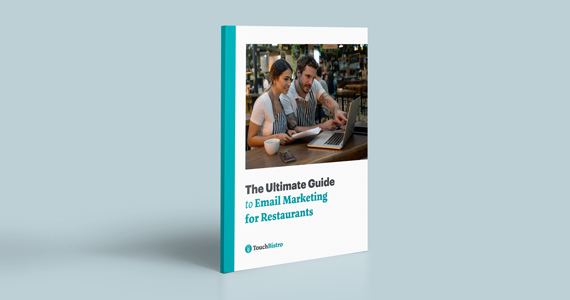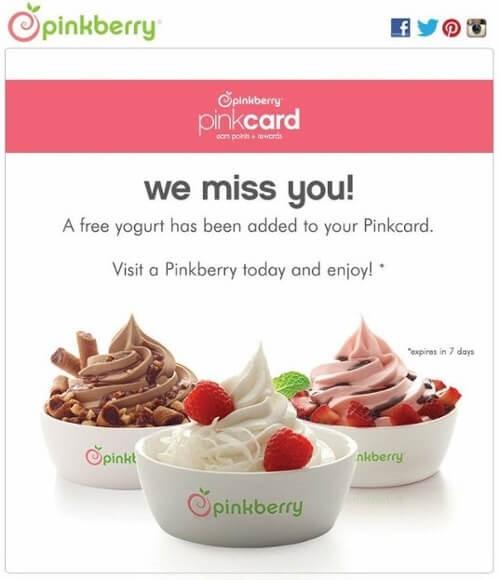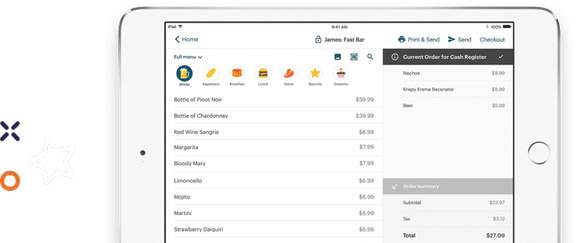Restaurant emails are one of the most effective forms of communication and automation has made it even easier to drive business results.
Rather than manually sending out emails one by one, automated email campaigns allow you to send emails to your audience by the thousands – just set it and forget it.
And since automated emails are often triggered by an action your subscribers take, like signing up for your newsletter or loyalty program, you can make these emails personalized and targeted to better engage your audience. In fact, 88% of U.S. marketers say they’ve seen measurable improvements due to personalization, according to Forbes.
Plus marketing automation emails are easy to create, affordable, and can be shared with the click of a button. So what are you waiting for? In this guide to automated restaurant emails, we’ll cover the ins and outs of why restaurants should consider automation as a primary technique to reach their customers. More specifically, this article will cover:
- What are automated email campaigns?
- 5 types of automated email campaigns with restaurant email examples
- The benefits of sending automated restaurant emails

Learn how to set up an email marketing strategy for your business in 6 easy steps.
What Are Automated Email Campaigns?
Automated email campaigns are a way for restaurateurs to send personalized restaurant emails to potential or existing customers at scale. Also commonly referred to as triggered emails or behavioral emails, automated email campaigns are automatically sent via your email service provider in response to a specific “trigger” – a customer action that you choose. In addition, you can also send data-driven messages, like automated birthday emails.
These emails can be personalized with the customer’s details and may include offers tailored directly to them. To make personalization even more effective, automated email campaigns can also be segmented, which means separating your audience into groups based on their preferences or actions. Once your audience is segmented, you can send out messages and offers that are relevant to each segment.
For instance, by using a restaurant marketing platform like TouchBistro Marketing in conjunction with a rewards program like TouchBistro Loyalty, you can segment your customers using a wide variety of filters and then personalize the emails you send based on guest behaviors, preferences, and order history. The more you know about your customers, the more relevant and targeted your automated campaigns can be.
For example, when customers have not visited your restaurant in 60 days, you can send them a ‘We miss you’ email with a promotion for 25% off their next bill.
Ultimately, automated email campaigns allow you to engage better with current or potential guests, which helps to foster loyalty, build trust, boost sales, or simply welcome a new customer.

To give you a better idea of restaurant trigger emails, here are a few examples:
- Sending a series of automated welcome emails to new customers who join your restaurant loyalty program to thank them for signing up.
- Asking for guests’ birthdays when they sign up for your restaurant newsletter and then sending personalized birthday offers on their special day.
- Sending a survey to customers after a visit to gain feedback on your menu items and service so you can improve your guest experience.
Ready to start using automation for restaurant emails? Continue reading to find out how to start sending automated emails.
How to Send Automated Email Campaigns
Now that you know more about the power of automated email campaigns, it’s time to learn how to send them to the right audience at the right time. Here are five easy steps you’ll need to follow to send automated email campaigns.
- Find an email marketing tool: First, you’ll need to choose a restaurant email marketing tool that supports email automation for your restaurant. One option is a platform like TouchBistro Marketing, which is a POS-integrated marketing platform that connects restaurants with their guests and drives repeat visits.
- Segment your audience: After choosing your email software, you’ll need to build a list of subscribers who you can send your automated restaurant emails to. For example, you could create a list of contacts who signed up for your loyalty program in the past month and start by sending them a welcome email series. You can also break up your email lists by characteristics like preferences or order history, so you can create more personalized messages and promotions. For example, you could send a ‘We loved having you’ email after a guests’ first visit followed by a ‘Come in for more of your favorites’ email a couple of weeks after their initial visit. In the second email, you could include a promotion for 15% off the menu item they ordered in their initial visit.
- Build your email campaigns: With your email list ready to go, now it’s time to bring your restaurant marketing ideas to life by creating eye-catching emails. Use a variety of images, banners, text, and call to action (CTA) buttons to drive different actions. With TouchBistro Marketing, this step is easy thanks to drag-and-drop email templates and easy-to-use design tools.
- Set up your automation triggers and send frequency: Next, you’ll need to set up triggers – an event that will send your automated campaign – like a newsletter signup, a new loyalty member signup, a birthday, or the date of a guests’ last visit to your restaurant.
- Analyze the performance of your campaigns: After your restaurant emails are sent, you can check on each campaign’s performance by accessing detailed reports on the performance of each campaign.
With these steps top of mind, let’s look at some of the top types of automated email campaigns that you can send.

Learn how to set up an email marketing strategy for your business in 6 easy steps.
5 Types of Automated Email Campaigns
Ready to start acquiring and engaging your customers? Here, we’ve outlined five different types of automated email campaigns and how you can use them to increase your orders and foot traffic. Plus, we’ve included handy restaurant email examples for each type.

1. Restaurant Welcome Email
One of the best ways to engage new subscribers is to set up a series of restaurant welcome emails. This type of automated email campaign helps you immediately make a good first impression by thanking new subscribers for signing up for your restaurant’s email list, newsletter, or your loyalty program. For example, send welcome offers, let them know more about your restaurant and the menu items you sell, or inform them of what to expect in future emails.
Benefits of Welcome Emails
According to Campaign Monitor, welcome email read rates are 42% higher than the average email. These emails are at the very beginning of your restaurant-guest relationship, which makes them a great opportunity to introduce your brand or loyalty program in the best light possible.
Here are a few ways automated welcome emails can benefit your restaurant:
- Help your restaurant make a good first impression with subscribers by introducing your brand’s founding story, mission, and values.
- Introduce tempting offers, like welcome discounts, to drive bigger orders. Or, redirect your guests to other webpages, like your restaurant’s online ordering page or your reservations page, to drive more traffic to your venue
- Thank your readers for being a part of your community and let them know what they should expect in future emails, like exclusive promotions and deals.
Example of a Restaurant Welcome Email
Eugene’s Gulf Coast Cuisine offers guests a welcome offer of $10 off on their next visit as a thank you for signing up to the restaurant’s email list. This offer is only valid for new newsletter subscribers and expires in 30 days, which creates a sense of urgency and help drive orders.

2. Loyalty Program Onboarding Email
A loyalty onboarding email is sent automatically after someone signs up for a restaurant’s rewards program. You can let new program members know what to expect, how to earn more rewards, or provide updates on your current menu items and promotions. Overall, these restaurant emails should help to build a strong relationship with guests and encourage them to continuously engage with your loyalty program.
Benefits of Onboarding Emails
Sending automated onboarding emails can provide many benefits, such as:
- Keeping your restaurant top of mind with regular offers and promotions.
- Explaining how your loyalty program works so guests know how they can earn and redeem their points, encouraging them to order more and engage more often.
- Letting guests know about their account status, like points earned, new offers available to them, or how many more points they need to earn a free meal or a special discount. Remember that your loyalty program is a two-way street. To build and retain members, you need to remind customers ‘what’s in it for them.’ Make it easy to understand the perks of your program to keep diners engaged with your loyalty program.
Example of a Restaurant Rewards Program Onboarding Email
The first email in Chipotle’s onboarding series is a great example of an automated email that helps build a strong relationship with guests, encourages them to earn rewards, and reminds them of the benefits of being a loyalty member. This email offers new members their first reward – a free side with chips after their first purchase. It also explains how a customer can earn further rewards through the app or in-venue. In addition, it outlines how many points per dollar you earn, and when you’re eligible for a free entree.

Source: reallygoodemails
3. Special Occasion Email
Another type of automated email is a special occasion message. This is usually sent on a special day, like a birthday, the anniversary of when a customer signed up for the email list, or a holiday like Thanksgiving or Christmas, for example. These automated restaurant emails often include an offer, which not only makes guests feel special and appreciated, but also prompts them to visit your restaurant.
Benefits of Special Occasion Email
Sending special occasion restaurant emails takes little effort on your part, but can provide many benefits, such as:
- Encouraging foot traffic from guests who may not have otherwise planned a visit to your location to celebrate a special occasion.
- Engaging past guests who haven’t visited your restaurant in a while in the hopes that they will become more frequent visitors.
- Building positive customer relationships by putting a smile on your readers’ faces with a friendly greeting and a nice gesture on a special occasion.
Example of a Special Occasion Email
A classic example of a special occasion email is Starbucks’ birthday reward email. Starbucks Rewards members automatically get an email on their birthday offering them a coupon for a free drink or food item of their choice to be redeemed on their special day.

Source: Starbucks

Learn how to set up an email marketing strategy for your business in 6 easy steps.
4. Review Request Email
Review request emails are automatically sent right after guests have visited your restaurant. These emails ask diners to leave a review of your restaurant while the experience is still fresh so you’re more likely to get a complete review.
Benefits of Request Emails
Setting up automated review request emails has many benefits, such as:
- You can ask open-ended questions that allow for guests to provide detailed feedback.
- You can ask many customers for reviews at the same time, without having to manually ask each one.
- You can share a link to the review platform of your choice, whether that’s Google, Yelp, TripAdvisor, or another platform.
Example of a Restaurant Request Email
Restaurants that use TouchBistro Reservations, like Fogo Island’s Bangbelly Cafe, are able to send emails to customers 24 hours after their visit. These types of emails not only help to garner more reviews for the restaurant, but they also provide an opportunity to thank the guest for their visit.

Source: Bangbelly Cafe
5. Re-Engagement Emails
Re-engagement emails can be used to help your restaurant “wake up” inactive subscribers. By providing an offer or a call to action, re-engagement emails can remind past customers of a special deal or a new menu item that they may want to try. Often, these emails are sent automatically after a period of inactivity, like if a diner hasn’t visited your restaurant in the past six months, or hasn’t engaged in your loyalty program for the past year.
Benefits of Re-Engagement Emails
Sending automatic re-engagement emails provides many benefits, such as:
- Retaining existing customers – instead of simply trying to attract new ones – by reminding them of your restaurant’s value and offerings.
- Increasing your revenue by driving more traffic to your restaurant with incentives, like a free appetizer or a special offer.
- Improving your reputation by showing your customers that you care about your relationship with them and hope they will stay.
Example of a Restaurant Re-Engagement Email
What better way to engage your audience than by offering a free dessert? This email by Pinkberry is simple yet effective because it shows that the brand misses and cares about its customers. Plus the line “a free yogurt has been added to your Pinkcard” reminds the reader that they are a loyalty program member and therefore they have access to some special perks they could be taking advantage of.

Source: Mailmunch
Benefits of Sending Automated Restaurant Emails
Now that you’re familiar with the different types of automated restaurant emails, let’s dive into the reasons behind why you would send them. Here are a few benefits of automated restaurant emails:
Eliminate Manual Tasks
With automated restaurant emails, you can send hundreds to thousands of emails at once without spending the time and effort of setting everything up manually. In addition, tools like audience segmentation, automatic triggers, and easy drag-and-drop design templates make it even easier for your team to personalize your content to improve customer engagement.
Improve the Customer Experience
Automated email campaigns can help customers get more out of your restaurant. Whether it’s a welcome message to help customers feel appreciated, a tip on how to make the most out of your loyalty program, or a personalized birthday offer, these emails provide a human touch and show that your restaurant cares about keeping customers satisfied.
Generate Recurring Revenue
Restaurant emails that are automated are targeted messages sent to the right customers at the right time to drive recurring revenue. For example, a restaurant can send various emails to encourage different actions, like making a reservation, redeeming an offer in-venue, or buying a digital gift card online. These emails help keep your restaurant top of mind so you can capture more sales opportunities that might otherwise be forgotten.

Learn how to set up an email marketing strategy for your business in 6 easy steps.
Gone are the days of wasting time and effort of having on sending emails manually. With automated restaurant emails, you can send hundreds or even thousands of emails without lifting a finger, which gives you more time to spend on other marketing efforts. And the perks don’t stop there. By using different kinds of automated emails, including restaurant welcome emails, loyalty program onboarding emails, special occasion emails, and more, you can increase your restaurant revenue by encouraging more reservations, visits, and orders. It’s time to start putting your restaurant marketing ideas to work!






